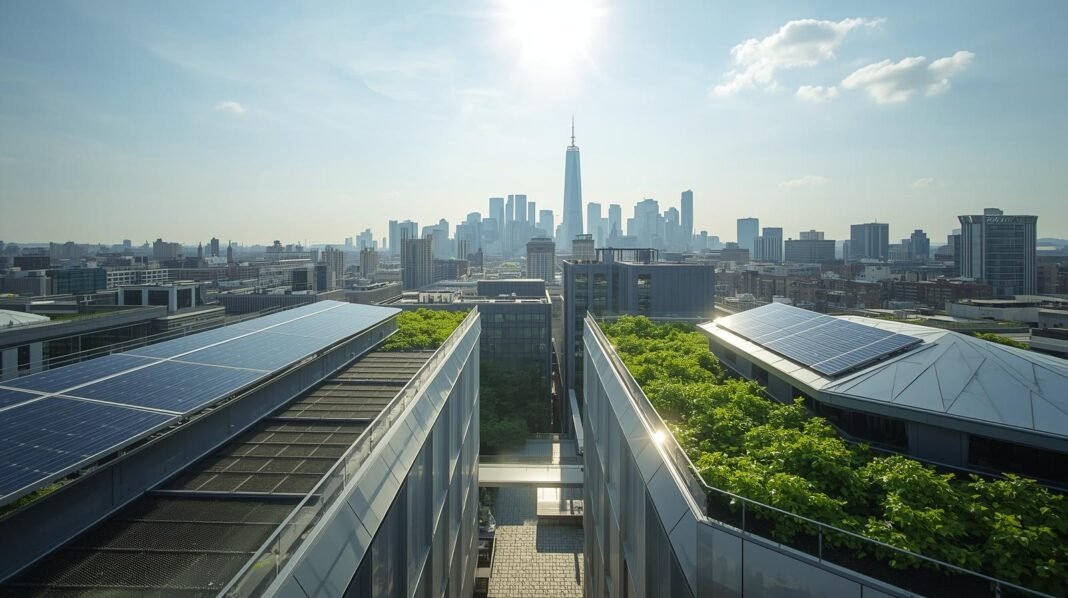The roofing industry is undergoing a transformation, driven by advancements in technology and a growing emphasis on sustainability.
As homeowners and commercial property owners seek more durable, efficient, and environmentally friendly solutions, innovative roofing technologies are emerging to meet these demands.
In this article, we will explore the key trends and technologies shaping the future of roofing, providing insights into how these innovations can enhance building performance and sustainability.
1. Smart Roofing Systems
The Rise of Smart Technology
The integration of smart technology into roofing systems is revolutionizing the way we think about building maintenance and energy efficiency. Smart roofs are equipped with sensors that monitor various environmental factors, such as temperature, humidity, and structural integrity. These sensors provide real-time data that can help homeowners and facility managers make informed decisions about maintenance, energy usage, and potential repairs.
Benefits of Smart Roofing Systems
- Energy Efficiency: Smart roofs can optimize energy consumption by adjusting to environmental conditions, ultimately reducing energy costs.
- Predictive Maintenance: By analyzing data from sensors, building owners can predict when repairs are needed, minimizing unexpected costs and downtime.
- Enhanced Comfort: Smart roofing systems can help maintain optimal indoor temperatures, contributing to occupant comfort.
2. Green Roofing Solutions
The Importance of Sustainability
As climate change becomes an increasingly pressing concern, the roofing industry is responding with sustainable practices. Green roofs, which are covered with vegetation, are gaining popularity for their numerous environmental benefits. They help to absorb rainwater, reduce the urban heat island effect, and improve air quality.
Types of Green Roofing Systems
- Extensive Green Roofs: These lightweight systems require minimal maintenance and are typically planted with low-growing vegetation.
- Intensive Green Roofs: These roofs can support a wider variety of plants and require more maintenance but offer greater aesthetic and environmental benefits.
Advantages of Green Roofing
- Improved Insulation: Green roofs provide natural insulation, reducing heating and cooling costs.
- Biodiversity: They create habitats for various species, promoting urban biodiversity.
- Stormwater Management: Green roofs can absorb and filter rainwater, reducing runoff and the risk of flooding.
3. Solar Roofing Technologies
Harnessing the Power of the Sun
Solar roofing technologies, such as solar shingles and integrated solar panels, are becoming mainstream solutions for renewable energy generation. These systems not only provide electricity but also contribute to the roofing structure’s aesthetics.
Types of Solar Roofing Technologies
- Solar Shingles: These look like traditional shingles but generate electricity. They are a seamless alternative for homeowners looking to install solar energy without compromising their roof’s appearance.
- Building-Integrated Photovoltaics (BIPV): BIPV systems integrate solar technology directly into building materials, such as roof tiles or facades, making them both functional and attractive.
Benefits of Solar Roofing
- Energy Independence: Homeowners can reduce their reliance on traditional energy sources, leading to lower utility bills.
- Increased Property Value: Solar installations can increase the value of a home, making it more attractive to potential buyers.
- Environmental Impact: By generating clean energy, solar roofs help reduce greenhouse gas emissions and contribute to a more sustainable future.
4. Advanced Roofing Materials
Innovations in Material Science
The future of roofing also lies in the development of advanced materials that offer greater durability, longevity, and performance. Traditional roofing materials, such as asphalt shingles and clay tiles, are being supplemented or replaced by innovative alternatives.
Emerging Roofing Materials
- Cool Roofs: These roofs are designed to reflect more sunlight and absorb less heat, helping to reduce energy consumption for cooling. They are often made from reflective coatings or special reflective materials.
- Synthetic Roofing Materials: Products made from synthetic polymers mimic traditional materials but offer enhanced durability and resistance to harsh weather conditions.
- Recyclable Roofing: Sustainable materials, such as recycled rubber or plastic, are being used to create roofing systems that minimize environmental impact.
Advantages of Advanced Roofing Materials
- Longevity: Many new materials offer longer life spans, reducing the frequency of replacements.
- Cost Savings: Durable materials can lead to lower long-term costs due to reduced maintenance and replacement needs.
- Environmental Benefits: Using sustainable or recyclable materials helps reduce waste and supports eco-friendly practices.
5. Modular Roofing Systems
The Shift Towards Prefabrication
Modular roofing systems are gaining traction due to their efficiency and ease of installation. These systems are manufactured off-site and assembled on-site, reducing labor costs and construction time.
Benefits of Modular Roofing Systems
- Speed of Installation: Prefabricated components can be installed quickly, minimizing disruption for building occupants.
- Quality Control: Manufacturing in a controlled environment leads to higher quality standards and less waste.
- Design Flexibility: Modular systems allow for greater customization, enabling architects and builders to create unique roof designs.
Conclusion
The future of roofing is bright, driven by innovative technologies and a commitment to sustainability. As the industry embraces smart systems, green solutions, solar technologies, advanced materials, and modular designs, building owners can look forward to more efficient, durable, and environmentally friendly roofing options.
By adopting these trends and technologies, we can pave the way for a more sustainable future in construction and architecture.
As a homeowner, contractor, or architect, staying informed about these trends will empower you to make better decisions regarding roofing projects, ultimately leading to a more sustainable and efficient built environment.
Whether it’s installing a smart roofing system, embracing green solutions, or opting for solar technologies, the future of roofing is undoubtedly set to transform the way we think about and interact with our buildings.
Also Read

